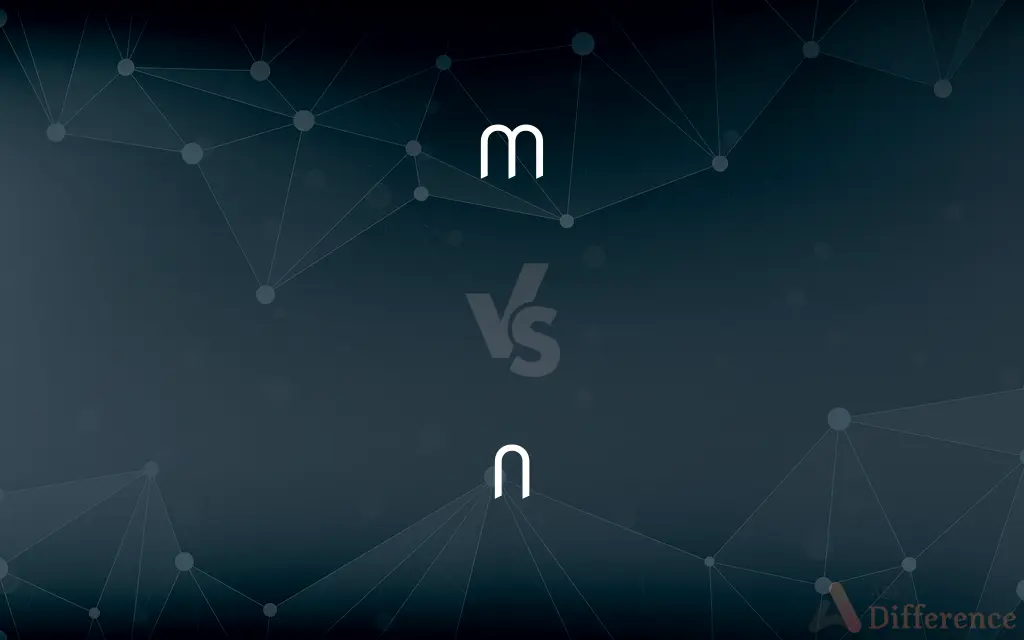M vs. N — What's the Difference?
By Fiza Rafique & Maham Liaqat — Updated on March 20, 2024
M is the 13th letter of the English alphabet, known for its consonant sound, whereas N is the 14th, distinct for its nasal consonant sound.

Difference Between M and N
Table of Contents
ADVERTISEMENT
Key Differences
M stands as the 13th letter in the English alphabet, often symbolizing a bilabial consonant where both lips meet to produce its sound. On the other hand, N is the 14th letter, characterized by its alveolar consonant where the tongue touches the roof of the mouth near the front teeth to create its unique sound.
M can indicate a sense of magnitude or mass in various scientific notations, such as representing 1000 in Roman numerals or denoting the metric prefix 'mega-' for one million. Whereas N is frequently used to denote 'newton', a unit of force in the International System of Units (SI), showcasing its significance in physics and engineering.
In phonetics, M’s sound is voiced and nasal, requiring airflow to escape through the nose, which gives it a distinct resonance. On the other hand, N also produces a voiced nasal sound, but the air passage through the nose creates a slightly different tonal quality due to its alveolar articulation.
In terms of usage, M is prevalent in words that suggest strength or solidity, such as "mountain" or "mass," reflecting its robust phonetic presence. N, on the other hand, often appears in words that convey action or movement, like "navigate" or "notice," mirroring its fluid and dynamic sound.
While M serves as an abbreviation for terms like "Monday" or "Meter" in calendars and measurements, highlighting its utility in diverse contexts, N is used to represent "North" in geographical orientations or "Nitrogen" in chemical formulas, underlining its versatility in both everyday and scientific language.
ADVERTISEMENT
Comparison Chart
Alphabetical Position
13th letter
14th letter
Sound Production
Bilabial, both lips meet
Alveolar, tongue near front teeth
Phonetic Type
Voiced, nasal
Voiced, nasal
Common Abbreviations
M (Meter, Monday)
N (North, Newton)
Usage in Words
Suggests strength (e.g., mountain)
Conveys action (e.g., navigate)
Compare with Definitions
M
Often stands for 'Meter' in measurements.
He ran 100M in just under 11 seconds.
N
Symbol for Nitrogen in the periodic table.
N2 is the chemical formula for nitrogen gas.
M
Symbolizes the number 1000.
MMXX was the Roman numeral for 2020.
N
Often signifies an unknown quantity.
Solve for N in the equation.
M
Represents the 13th letter of the English alphabet.
The word memory starts with an M.
N
Denotes the 14th letter of the English alphabet.
Nest begins with an N.
M
Indicates a major chord in music sheets.
The chord progression G to C was marked as G to Cm.
N
Used for 'North' in compass directions.
The map showed a path heading N.
M
Used to denote magnitude or mass.
M is for mega, which means a million.
N
Represents Newton, a force unit.
A force of 5N was applied to the object.
M
M, or m, is the thirteenth letter of the modern English alphabet and the ISO basic Latin alphabet. Its name in English is em (pronounced ), plural ems.
N
N, or n, is the fourteenth letter in the modern English alphabet and the ISO basic Latin alphabet. Its name in English is en (pronounced ), plural ens.
M
The 13th letter of the modern English alphabet.
N
The 14th letter of the modern English alphabet.
M
Any of the speech sounds represented by the letter m.
N
Any of the speech sounds represented by the letter n.
M
The 13th in a series.
N
The 14th in a series.
M
Something shaped like the letter M.
N
Something shaped like the letter N.
M
(grammar) masculine
N
An unspecified number or variable, usually an integer.
M
Abbreviation of meter
N
(Biology) The haploid number of chromosomes.
M
Abbreviation of mile
N
And
Mac 'n' cheese.
M
Abbreviation of month
N
C|en|Compass points}}{{abbreviation of north
M
Abbreviation of minute
N
(grammar) noun
M
Abbreviation of million
N
(organic chemistry) normal
M
Abbreviation of minim
N
Neutral
M
(music) measure
N
No
M
(obsolete) thousand
N
(grammar) neuter (gender).
M
(knitting) make
N
Contraction of andchiefly used in set phrases.
Rock n roll
M
M, the thirteenth letter of the English alphabet, is a vocal consonant, and from the manner of its formation, is called the labio-nasal consonant. See Guide to Pronunciation, 178-180, 242.
N
The fourteenth letter of English alphabet, is a vocal consonent, and, in allusion to its mode of formation, is called the dentinasal or linguanasal consonent. Its commoner sound is that heard in ran, done; but when immediately followed in the same word by the sound of g hard or k (as in single, sink, conquer), it usually represents the same sound as the digraph ng in sing, bring, etc. This is a simple but related sound, and is called the gutturo-nasal consonent. See Guide to Pronunciation, 243-246.
M
As a numeral, M stands for one thousand, both in English and Latin.
N
A measure of space equal to half an M (or em); an en.
M
A quadrat, the face or top of which is a perfect square; also, the size of such a square in any given size of type, used as the unit of measurement for that type: 500 m's of pica would be a piece of matter whose length and breadth in pica m's multiplied together produce that number.
N
(of a solution) concentration expressed in gram equivalents of solute per liter
M
A brand or stigma, having the shape of an M, formerly impressed on one convicted of manslaughter and admitted to the benefit of clergy.
N
A common nonmetallic element that is normally a colorless odorless tasteless inert diatomic gas; constitutes 78 percent of the atmosphere by volume; a constituent of all living tissues
M
The basic unit of length adopted under the Systeme International d'Unites (approximately 1.094 yards)
N
The cardinal compass point that is at 0 or 360 degrees
M
Concentration measured by the number of moles of solute per liter of solvent
N
A unit of force equal to the force that imparts an acceleration of 1 m/sec/sec to a mass of 1 kilogram; equal to 100,000 dynes
M
The cardinal number that is the product of 10 and 100
N
The 14th letter of the Roman alphabet
M
The 13th letter of the Roman alphabet
M
Denoting a quantity consisting of 1,000 items or units
Common Curiosities
Are there any common words that start with M and N?
Yes, "mountain" starts with M, and "navigate" starts with N, showcasing their different phonetic qualities.
What scientific fields use M and N as abbreviations?
M is widely used in physics and mathematics, whereas N is significant in physics and geography.
How do M and N contribute to word meanings?
Words starting with M often imply strength or size, whereas words beginning with N tend to convey action or direction.
What are some key differences in the use of M and N in scientific notations?
M is used for the metric prefix "mega-" and as a Roman numeral, while N stands for the unit "newton" and symbolizes nitrogen in chemistry.
How are M and N used in abbreviations?
M can stand for "Monday" or "Meter," while N can represent "North" or "Newton."
Can M and N be used interchangeably in any context?
No, M and N have distinct phonetic and symbolic uses and cannot be used interchangeably.
Can M or N be silent in words?
Yes, in some words, M or N can be silent, although this is more common with N, as in "autumn."
How does the pronunciation of M and N affect their use in languages other than English?
The pronunciation of M and N is relatively consistent across languages, making their phonetic characteristics universally recognizable.
What are the challenges in teaching the pronunciation of M and N to non-native speakers?
The main challenge lies in teaching the correct mouth and tongue positions to produce the distinct sounds of M and N.
What is the primary difference in sound between M and N?
M is produced by pressing both lips together, while N is made by pressing the tongue against the roof of the mouth near the front teeth.
What roles do M and N play in music notation?
M can indicate a major chord in music, while N does not have a specific notation in standard music theory.
Do M and N have any numerical significance?
M represents 1000 in Roman numerals, while N does not have a direct numerical significance but is used in mathematical expressions to denote variables or quantities.
How have M and N been represented in historical alphabets or scripts?
In historical scripts, such as Roman and Greek, M and N have had consistent representations due to their fundamental phonetic properties.
Are there any cultural or symbolic meanings associated with M and N?
Cultural or symbolic meanings of letters vary, but M and N themselves are not typically associated with specific cultural symbols.
How do M and N compare in terms of frequency in the English language?
Both M and N are frequently used, but their distribution varies with N being slightly more common in English texts.
Share Your Discovery

Previous Comparison
Vice vs. Versus
Next Comparison
Clear vs. UnambiguousAuthor Spotlight
Written by
Fiza RafiqueFiza Rafique is a skilled content writer at AskDifference.com, where she meticulously refines and enhances written pieces. Drawing from her vast editorial expertise, Fiza ensures clarity, accuracy, and precision in every article. Passionate about language, she continually seeks to elevate the quality of content for readers worldwide.
Co-written by
Maham Liaqat












































